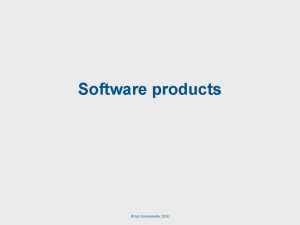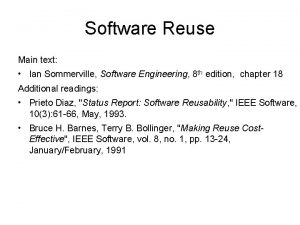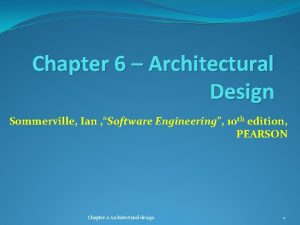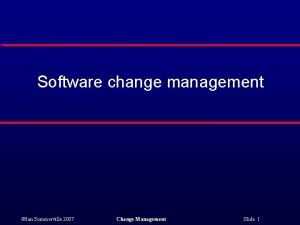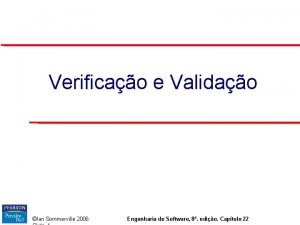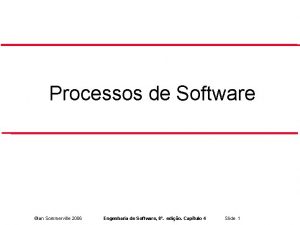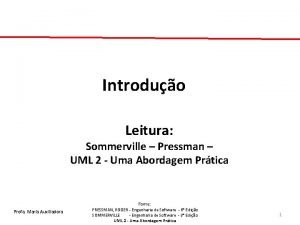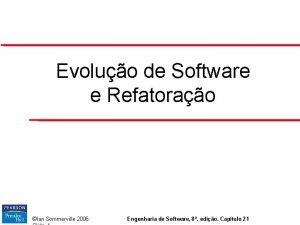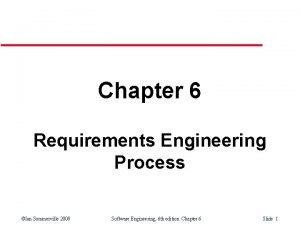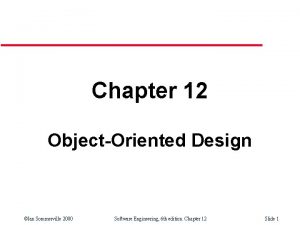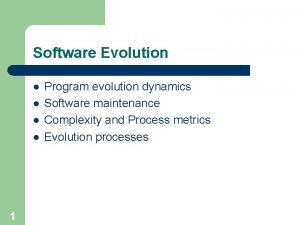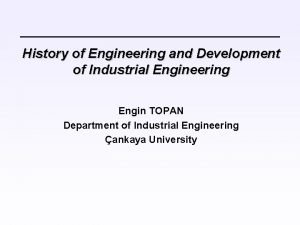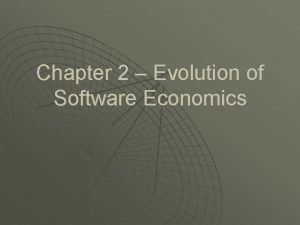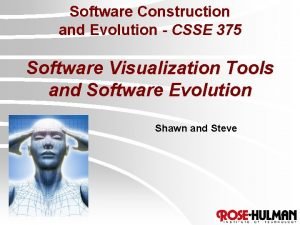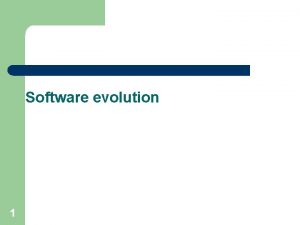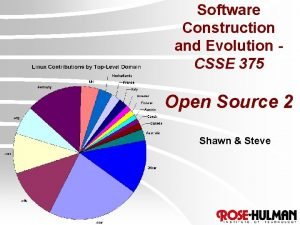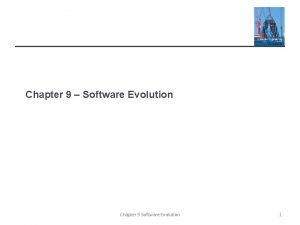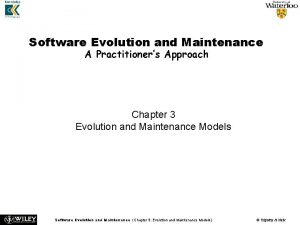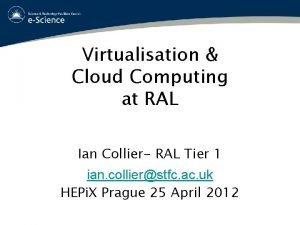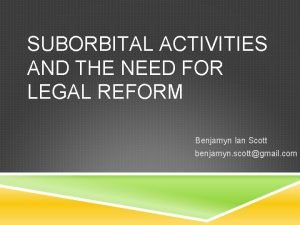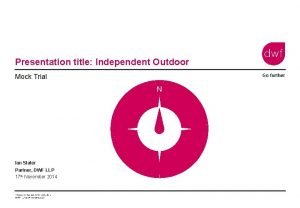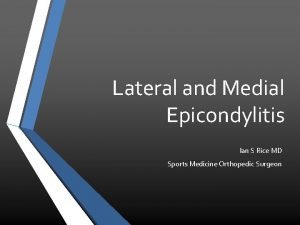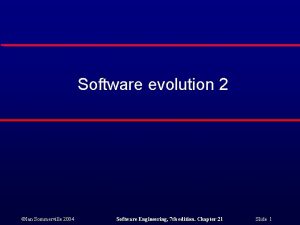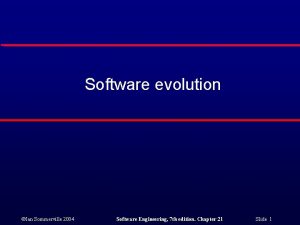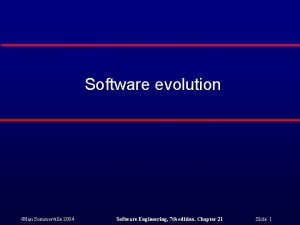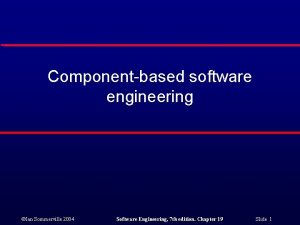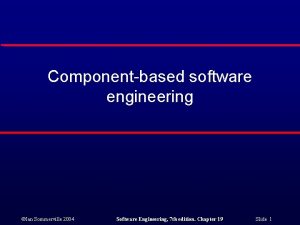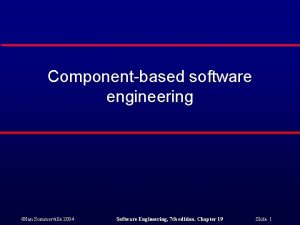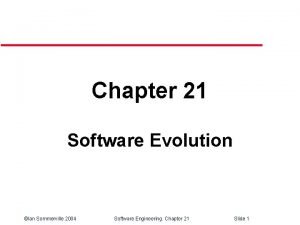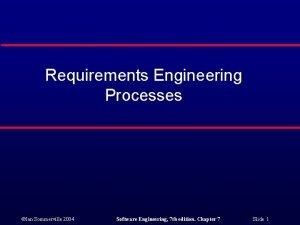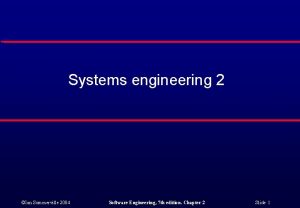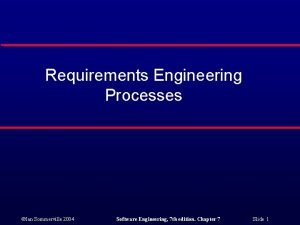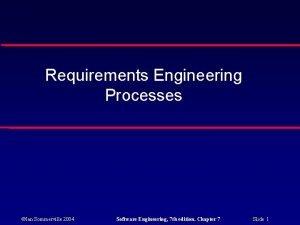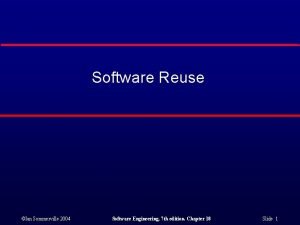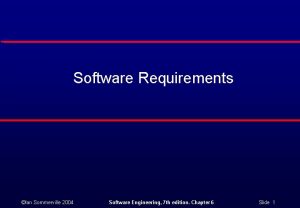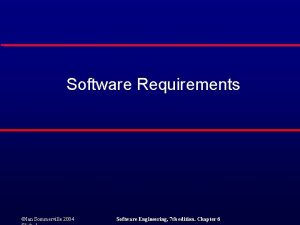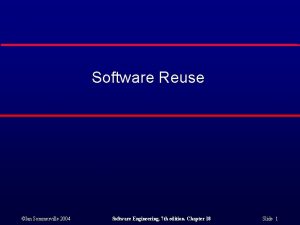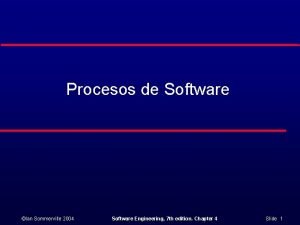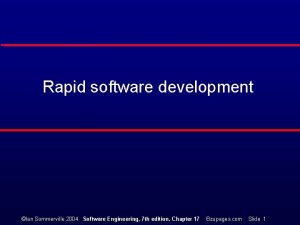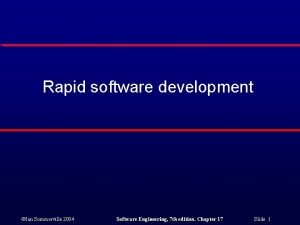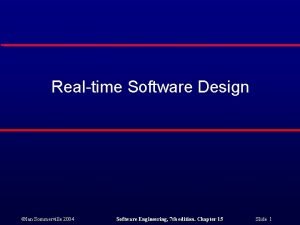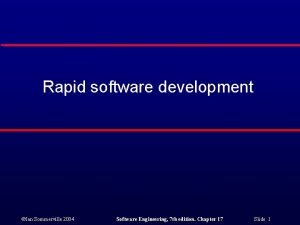Software evolution Ian Sommerville 2004 Software Engineering 7















































- Slides: 47

Software evolution ©Ian Sommerville 2004 Software Engineering, 7 th edition. Chapter 21 Slide 1

Objectives l l To explain why change is inevitable if software systems are to remain useful To discuss software maintenance and maintenance cost factors To describe the processes involved in software evolution To discuss an approach to assessing evolution strategies for legacy systems ©Ian Sommerville 2004 Software Engineering, 7 th edition. Chapter 21 Slide 2

Topics covered l l Program evolution dynamics Software maintenance Evolution processes Legacy system evolution ©Ian Sommerville 2004 Software Engineering, 7 th edition. Chapter 21 Slide 3

Software change l Software change is inevitable • • • l New requirements emerge when the software is used; The business environment changes; Errors must be repaired; New computers and equipment is added to the system; The performance or reliability of the system may have to be improved. A key problem for organisations is implementing and managing change to their existing software systems. ©Ian Sommerville 2004 Software Engineering, 7 th edition. Chapter 21 Slide 4

Importance of evolution l l l Organisations have huge investments in their software systems - they are critical business assets. To maintain the value of these assets to the business, they must be changed and updated. The majority of the software budget in large companies is devoted to evolving existing software rather than developing new software. ©Ian Sommerville 2004 Software Engineering, 7 th edition. Chapter 21 Slide 5

Spiral model of evolution ©Ian Sommerville 2004 Software Engineering, 7 th edition. Chapter 21 Slide 6

21. 1. Program evolution dynamics l l l Program evolution dynamics is the study of the processes of system change. After major empirical studies, Lehman and Belady proposed that there were a number of ‘laws’ which applied to all systems as they evolved. There are sensible observations rather than laws. They are applicable to large systems developed by large organisations. Perhaps less applicable in other cases. ©Ian Sommerville 2004 Software Engineering, 7 th edition. Chapter 21 Slide 7

Lehman’s laws ©Ian Sommerville 2004 Software Engineering, 7 th edition. Chapter 21 Slide 8

Applicability of Lehman’s laws l Lehman’s laws seem to be generally applicable to large, tailored systems developed by large organisations. • l Confirmed in more recent work by Lehman on the FEAST project (see further reading on book website). It is not clear how they should be modified for • • Shrink-wrapped software products; Systems that incorporate a significant number of COTS components; Small organisations; Medium sized systems. ©Ian Sommerville 2004 Software Engineering, 7 th edition. Chapter 21 Slide 9

21. 2. Software maintenance l l l Modifying a program after it has been put into use. Maintenance does not normally involve major changes to the system’s architecture. Changes are implemented by modifying existing components and adding new components to the system. ©Ian Sommerville 2004 Software Engineering, 7 th edition. Chapter 21 Slide 10

Maintenance is inevitable l l l The system requirements are likely to change while the system is being developed because the environment is changing. Therefore a delivered system won't meet its requirements! Systems are tightly coupled with their environment. When a system is installed in an environment it changes that environment and therefore changes the system requirements. Systems MUST be maintained therefore if they are to remain useful in an environment. ©Ian Sommerville 2004 Software Engineering, 7 th edition. Chapter 21 Slide 11

Types of maintenance l Maintenance to repair software faults • l Maintenance to adapt software to a different operating environment • l Changing a system to correct deficiencies in the way meets its requirements. Changing a system so that it operates in a different environment (computer, OS, etc. ) from its initial implementation. Maintenance to add to or modify the system’s functionality • Modifying the system to satisfy new requirements. ©Ian Sommerville 2004 Software Engineering, 7 th edition. Chapter 21 Slide 12

Distribution of maintenance effort ©Ian Sommerville 2004 Software Engineering, 7 th edition. Chapter 21 Slide 13

Maintenance costs l l Usually greater than development costs (2* to 100* depending on the application). Affected by both technical and non-technical factors. Increases as software is maintained. Maintenance corrupts the software structure so makes further maintenance more difficult. Ageing software can have high support costs (e. g. old languages, compilers etc. ). ©Ian Sommerville 2004 Software Engineering, 7 th edition. Chapter 21 Slide 14

Development/maintenance costs ©Ian Sommerville 2004 Software Engineering, 7 th edition. Chapter 21 Slide 15

Maintenance cost factors l Team stability • l Contractual responsibility • l The developers of a system may have no contractual responsibility for maintenance so there is no incentive to design for future change. Staff skills • l Maintenance costs are reduced if the same staff are involved with them for some time. Maintenance staff are often inexperienced and have limited domain knowledge. Program age and structure • As programs age, their structure is degraded and they become harder to understand change. ©Ian Sommerville 2004 Software Engineering, 7 th edition. Chapter 21 Slide 16

Maintenance prediction l Maintenance prediction is concerned with assessing which parts of the system may cause problems and have high maintenance costs • • • Change acceptance depends on the maintainability of the components affected by the change; Implementing changes degrades the system and reduces its maintainability; Maintenance costs depend on the number of changes and costs of change depend on maintainability. ©Ian Sommerville 2004 Software Engineering, 7 th edition. Chapter 21 Slide 17

Maintenance prediction ©Ian Sommerville 2004 Software Engineering, 7 th edition. Chapter 21 Slide 18

Change prediction l l l Predicting the number of changes requires and understanding of the relationships between a system and its environment. Tightly coupled systems require changes whenever the environment is changed. Factors influencing this relationship are • • • Number and complexity of system interfaces; Number of inherently volatile system requirements; The business processes where the system is used. ©Ian Sommerville 2004 Software Engineering, 7 th edition. Chapter 21 Slide 19

Complexity metrics l l l Predictions of maintainability can be made by assessing the complexity of system components. Studies have shown that most maintenance effort is spent on a relatively small number of system components. Complexity depends on • • • Complexity of control structures; Complexity of data structures; Object, method (procedure) and module size. ©Ian Sommerville 2004 Software Engineering, 7 th edition. Chapter 21 Slide 20

Process metrics l Process measurements may be used to assess maintainability • • l Number of requests for corrective maintenance; Average time required for impact analysis; Average time taken to implement a change request; Number of outstanding change requests. If any or all of these is increasing, this may indicate a decline in maintainability. ©Ian Sommerville 2004 Software Engineering, 7 th edition. Chapter 21 Slide 21

21. 3. Evolution processes l Evolution processes depend on • • • l The type of software being maintained; The development processes used; The skills and experience of the people involved. Proposals for change are the driver for system evolution. Change identification and evolution continue throughout the system lifetime. ©Ian Sommerville 2004 Software Engineering, 7 th edition. Chapter 21 Slide 22

Change identification and evolution ©Ian Sommerville 2004 Software Engineering, 7 th edition. Chapter 21 Slide 23

The system evolution process ©Ian Sommerville 2004 Software Engineering, 7 th edition. Chapter 21 Slide 24

Change implementation ©Ian Sommerville 2004 Software Engineering, 7 th edition. Chapter 21 Slide 25

Urgent change requests l Urgent changes may have to be implemented without going through all stages of the software engineering process • • • If a serious system fault has to be repaired; If changes to the system’s environment (e. g. an OS upgrade) have unexpected effects; If there are business changes that require a very rapid response (e. g. the release of a competing product). ©Ian Sommerville 2004 Software Engineering, 7 th edition. Chapter 21 Slide 26

Emergency repair ©Ian Sommerville 2004 Software Engineering, 7 th edition. Chapter 21 Slide 27

System re-engineering l l l Re-structuring or re-writing part or all of a legacy system without changing its functionality. Applicable where some but not all sub-systems of a larger system require frequent maintenance. Re-engineering involves adding effort to make them easier to maintain. The system may be restructured and re-documented. ©Ian Sommerville 2004 Software Engineering, 7 th edition. Chapter 21 Slide 28

Advantages of reengineering l Reduced risk • l There is a high risk in new software development. There may be development problems, staffing problems and specification problems. Reduced cost • The cost of re-engineering is often significantly less than the costs of developing new software. ©Ian Sommerville 2004 Software Engineering, 7 th edition. Chapter 21 Slide 29

Forward and re-engineering ©Ian Sommerville 2004 Software Engineering, 7 th edition. Chapter 21 Slide 30

The re-engineering process ©Ian Sommerville 2004 Software Engineering, 7 th edition. Chapter 21 Slide 31

Reengineering process activities l Source code translation • l Reverse engineering • l Restructure automatically for understandability; Program modularisation • l Analyse the program to understand it; Program structure improvement • l Convert code to a new language. Reorganise the program structure; Data reengineering • Clean-up and restructure system data. ©Ian Sommerville 2004 Software Engineering, 7 th edition. Chapter 21 Slide 32

Re-engineering approaches ©Ian Sommerville 2004 Software Engineering, 7 th edition. Chapter 21 Slide 33

Reengineering cost factors l l The quality of the software to be reengineered. The tool support available for reengineering. The extent of the data conversion which is required. The availability of expert staff for reengineering. • This can be a problem with old systems based on technology that is no longer widely used. ©Ian Sommerville 2004 Software Engineering, 7 th edition. Chapter 21 Slide 34

21. 4. Legacy system evolution l Organisations that rely on legacy systems must choose a strategy for evolving these systems • • l Scrap the system completely and modify business processes so that it is no longer required; Continue maintaining the system; Transform the system by re-engineering to improve its maintainability; Replace the system with a new system. The strategy chosen should depend on the system quality and its business value. ©Ian Sommerville 2004 Software Engineering, 7 th edition. Chapter 21 Slide 35

System quality and business value ©Ian Sommerville 2004 Software Engineering, 7 th edition. Chapter 21 Slide 36

Legacy system categories l Low quality, low business value • l Low-quality, high-business value • l These make an important business contribution but are expensive to maintain. Should be re-engineered or replaced if a suitable system is available. High-quality, low-business value • l These systems should be scrapped. Replace with COTS, scrap completely or maintain. High-quality, high business value • Continue in operation using normal system maintenance. ©Ian Sommerville 2004 Software Engineering, 7 th edition. Chapter 21 Slide 37

Business value assessment l Assessment should take different viewpoints into account • • • l System end-users; Business customers; Line managers; IT managers; Senior managers. Interview different stakeholders and collate results. ©Ian Sommerville 2004 Software Engineering, 7 th edition. Chapter 21 Slide 38

System quality assessment l Business process assessment • l Environment assessment • l How well does the business process support the current goals of the business? How effective is the system’s environment and how expensive is it to maintain? Application assessment • What is the quality of the application software system? ©Ian Sommerville 2004 Software Engineering, 7 th edition. Chapter 21 Slide 39

Business process assessment l Use a viewpoint-oriented approach and seek answers from system stakeholders • • • l Is there a defined process model and is it followed? Do different parts of the organisation use different processes for the same function? How has the process been adapted? What are the relationships with other business processes and are these necessary? Is the process effectively supported by the legacy application software? Example - a travel ordering system may have a low business value because of the widespread use of web-based ordering. ©Ian Sommerville 2004 Software Engineering, 7 th edition. Chapter 21 Slide 40

Environment assessment 1 ©Ian Sommerville 2004 Software Engineering, 7 th edition. Chapter 21 Slide 41

Environment assessment 2 ©Ian Sommerville 2004 Software Engineering, 7 th edition. Chapter 21 Slide 42

Application assessment 1 ©Ian Sommerville 2004 Software Engineering, 7 th edition. Chapter 21 Slide 43

Application assessment 2 ©Ian Sommerville 2004 Software Engineering, 7 th edition. Chapter 21 Slide 44

System measurement l You may collect quantitative data to make an assessment of the quality of the application system • • • The number of system change requests; The number of different user interfaces used by the system; The volume of data used by the system. ©Ian Sommerville 2004 Software Engineering, 7 th edition. Chapter 21 Slide 45

Key points l l Software development and evolution should be a single iterative process. Lehman’s Laws describe a number of insights into system evolution. Three types of maintenance are bug fixing, modifying software for a new environment and implementing new requirements. For custom systems, maintenance costs usually exceed development costs. ©Ian Sommerville 2004 Software Engineering, 7 th edition. Chapter 21 Slide 46

Key points l l l The process of evolution is driven by requests for changes from system stakeholders. Software re-engineering is concerned with restructuring and re-documenting software to make it easier to change. The business value of a legacy system and its quality should determine the evolution strategy that is used. ©Ian Sommerville 2004 Software Engineering, 7 th edition. Chapter 21 Slide 47
 Engineering software products ian sommerville
Engineering software products ian sommerville Ian sommerville software engineering
Ian sommerville software engineering Inżynieria oprogramowania ian sommerville
Inżynieria oprogramowania ian sommerville Sommerville software engineering slides
Sommerville software engineering slides Change management in software testing
Change management in software testing Sommerville
Sommerville Sommerville
Sommerville Sommerville
Sommerville Sommerville
Sommerville Sommerville
Sommerville Sommerville
Sommerville Sommerville
Sommerville Elaine sommerville
Elaine sommerville 666 rule powerpoint
666 rule powerpoint Program evolution dynamics in software engineering
Program evolution dynamics in software engineering System procurement process in software engineering
System procurement process in software engineering Forward engineering in software engineering
Forward engineering in software engineering Industrial engineering timeline
Industrial engineering timeline Software maintenance in software engineering ppt
Software maintenance in software engineering ppt Frank maurer
Frank maurer What is software metrics in software engineering
What is software metrics in software engineering Types of software crisis
Types of software crisis Software measurement and metrics
Software measurement and metrics Real time software design in software engineering
Real time software design in software engineering Software design fundamentals in software engineering
Software design fundamentals in software engineering Explain the evolution of software economics.
Explain the evolution of software economics. Evolution construction software
Evolution construction software Software evolution
Software evolution Evolution construction software
Evolution construction software 9 chapter
9 chapter Software maintenance
Software maintenance Principles of complex systems for systems engineering
Principles of complex systems for systems engineering Elegant systems
Elegant systems Forward and reverse engineering
Forward and reverse engineering Ian milborrow pwc
Ian milborrow pwc Ian juliano
Ian juliano Cloud ral
Cloud ral Dr ian arnott
Dr ian arnott Ian scott international
Ian scott international Ian lipio
Ian lipio Ian coddington
Ian coddington Ian j goodfellow
Ian j goodfellow Ian crotty
Ian crotty Ian slater dwf
Ian slater dwf Ian lindsley
Ian lindsley Albert tomasso
Albert tomasso Norctin
Norctin Ian francis cluny macpherson
Ian francis cluny macpherson
